
The Gospel of Mark is the second of the four canonical gospels and one of the three synoptic Gospels. It tells of the ministry of Jesus from his baptism by John the Baptist to his death, burial of his body, and the discovery of his empty tomb. It portrays Jesus as a teacher, an exorcist, a healer, and a miracle worker, though it does not mention a miraculous birth or divine pre-existence. He refers to himself as the Son of Man. He is called the Son of God but keeps his messianic nature secret; even his disciples fail to understand him. All this is in keeping with Christian interpretation of prophecy, which is believed to foretell the fate of the messiah as suffering servant.

The Gospel of Matthew is the first book of the New Testament of the Bible and one of the three synoptic Gospels. It tells how Israel's Messiah, Jesus, comes to his people but is rejected by them and how, after his resurrection, he sends the disciples to the gentiles instead. Matthew wishes to emphasize that the Jewish tradition should not be lost in a church that was increasingly becoming gentile. The gospel reflects the struggles and conflicts between the evangelist's community and the other Jews, particularly with its sharp criticism of the scribes and Pharisees with the position that through their rejection of Christ, the Kingdom of God has been taken away from them and given instead to the church.

Matthew the Apostle is named in the New Testament as one of the twelve apostles of Jesus. According to Christian traditions, he was also one of the four Evangelists as author of the Gospel of Matthew, and thus is also known as Matthew the Evangelist.

The gospels of Matthew, Mark, and Luke are referred to as the synoptic Gospels because they include many of the same stories, often in a similar sequence and in similar or sometimes identical wording. They stand in contrast to John, whose content is largely distinct. The term synoptic comes via Latin from the Greek σύνοψις, synopsis, i.e. "(a) seeing all together, synopsis"; the sense of the word in English, the one specifically applied to these three gospels, of "giving an account of the events from the same point of view or under the same general aspect" is a modern one.

In Christianity, Jesus is the Son of God as written in the Bible's New Testament, and in mainstream Christian denominations he is God the Son, the second Person in the Trinity. Christians believe him to be the messiah prophesied in the Bible's Old Testament. Through Jesus's crucifixion and resurrection, Christians believe that God offers humans salvation and eternal life, with Jesus's death atoning for all sin, thus making humanity right with God.

The miracles of Jesus are miraculous deeds attributed to Jesus in Christian and Islamic texts. The majority are faith healings, exorcisms, resurrections, and control over nature.

Jesus, also referred to as Jesus Christ, Jesus of Nazareth, and several other names and titles, was a first-century Jewish preacher and religious leader. He is the central figure of Christianity, the world's largest religion. Most Christians believe Jesus to be the incarnation of God the Son and the awaited messiah, the Christ that is prophesied in the Hebrew Bible.
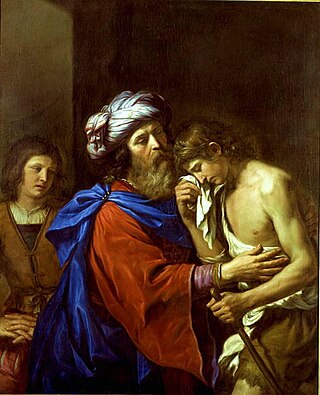
The parables of Jesus are found in the Synoptic Gospels and some of the non-canonical gospels. They form approximately one third of his recorded teachings. Christians place great emphasis on these parables, which they generally regard as the words of Jesus.
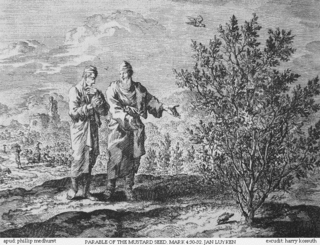
The Parable of the Mustard Seed is one of the shorter parables of Jesus. It appears in Matthew (13:31–32), Mark (4:30–32), and Luke (13:18–19). In the Gospels of Matthew and Luke, it is immediately followed by the Parable of the Leaven, which shares this parable's theme of the Kingdom of Heaven growing from small beginnings. It also appears in the non-canonical Gospel of Thomas.

Mark 5 is the fifth chapter of the Gospel of Mark in the New Testament of the Christian Bible. Taken with the calming of the sea in Mark 4:35–41, there are "four striking works [which] follow each other without a break": an exorcism, a healing, and the raising of Jairus' daughter.

Matthew 8 is the eighth chapter of the Gospel of Matthew in the New Testament and continues the narrative about Jesus' ministry in Galilee previously described in Matthew 4:23–25. It follows on from the Sermon on the Mount, noting in its opening verse that Jesus had come down from the mountain where he had been teaching. There is a renewed focus in this chapter on Jesus' ministry of healing.

Luke 8 is the eighth chapter of the Gospel of Luke in the New Testament of the Christian Bible. The book containing this chapter is anonymous but early Christian tradition uniformly affirmed that Luke the Evangelist, a companion of Paul the Apostle on his missionary journeys, composed both this Gospel and the Acts of the Apostles. This chapter mentions the women who supported Jesus and records some of the great miracles he performed, as well as several parables told by him.

The Parable of the strong man is a parable told by Jesus in the New Testament, found in Matt 12:29, Mark 3:27, and Luke 11:21–22, and also in the non-canonical Gospel of Thomas where it is known as logion 35
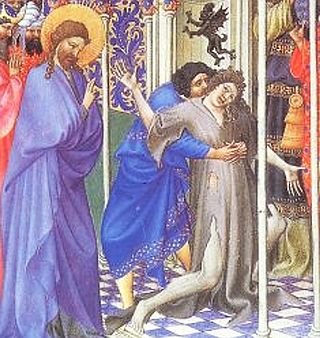
In English translations of the Bible, unclean spirit is a common rendering of Greek pneuma akatharton, which in its single occurrence in the Septuagint translates Hebrew ruaḥ tum'ah.

Healing the centurion's servant is one of the miracles performed by Jesus of Nazareth as related in the Gospel of Matthew and the Gospel of Luke. The story is not recounted in the Gospels of either John or Mark.

The exorcism of the Gerasene demoniac, frequently known as the Miracle of the (Gadarene) Swine and the exorcism of Legion, is one of the miracles performed by Jesus according to the New Testament. The story shows Jesus exorcising a demon or demons out of a man and into a herd of swine, causing the swine to run down a hill into a lake and drown themselves.

The exorcism of a boy possessed by a demon, or a boy with a mute spirit, is one of the miracles attributed to Jesus reported in the synoptic Gospels, involving the healing of a demonically possessed boy through exorcism. The account appears first in the Mark 9:17-29 and is repeated, slightly amended, in Matthew 17:14-21 and Luke 9:40-44. In the Gospel narratives, this healing takes place following the Transfiguration.
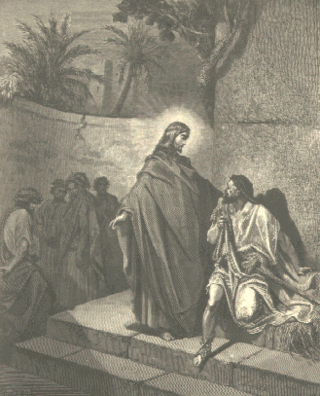
In Christianity, exorcism involves the practice of casting out one or more demons from a person whom they are believed to have possessed. The person performing the exorcism, known as an exorcist, is often a member of the Christian Church, or an individual thought to be graced with special powers or skills. The exorcist may use prayers and religious material, such as set formulas, gestures, symbols, icons, or amulets. The exorcist often invokes God, Jesus, angels and archangels, and various saints to aid with the exorcism. Christian exorcists most commonly cast out demons in Jesus' name.

Oral gospel traditions is the hypothetical first stage in the formation of the written gospels as information was passed by word of mouth. These oral traditions included different types of stories about Jesus. For example, people told anecdotes about Jesus healing the sick and debating with his opponents. The traditions also included sayings attributed to Jesus, such as parables and teachings on various subjects which, along with other sayings, formed the oral gospel tradition. The supposition of such traditions have been the focus of scholars such as Bart Ehrman, James Dunn, and Richard Bauckham, although each scholar varies widely in his conclusions, with Ehrman and Bauckham publicly debating on the subject.
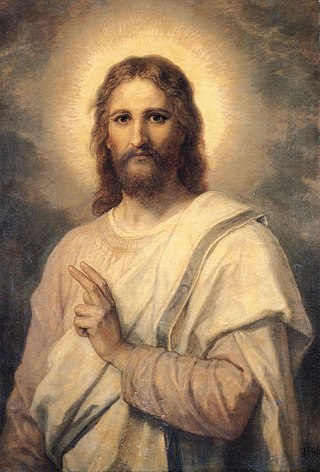
The following outline is provided as an overview of and topical guide to Wikipedia articles on the life and influence of Jesus.




















